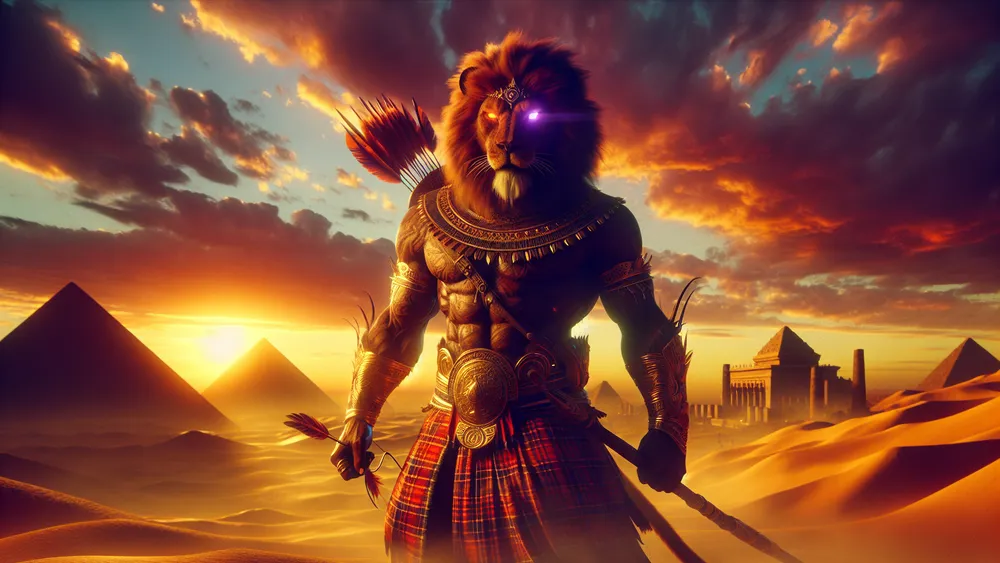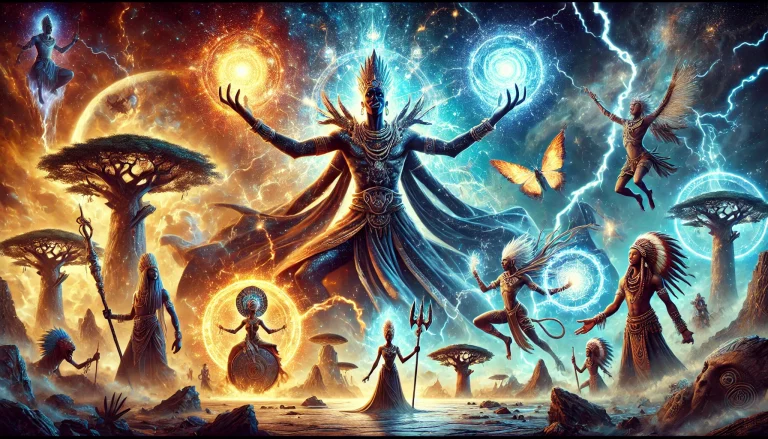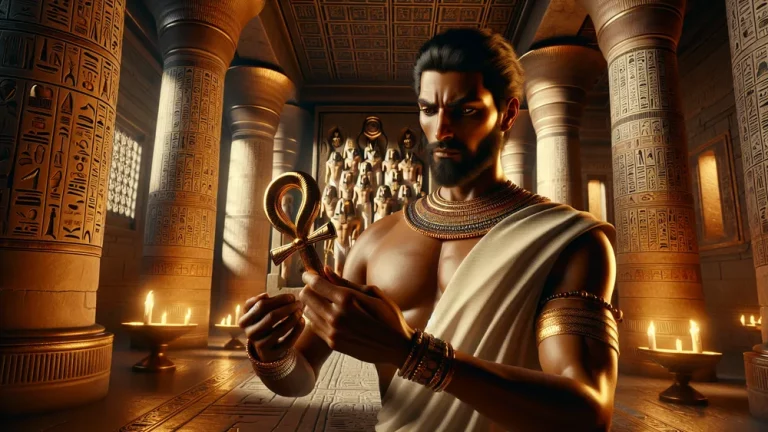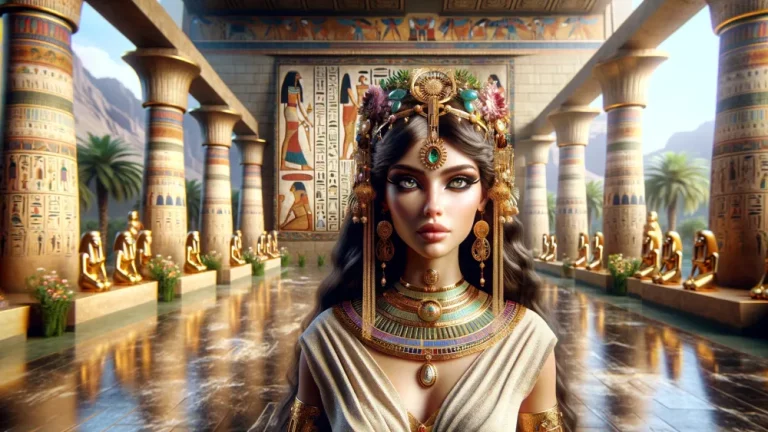Anhur: Ancient Egyptian God Of War and Hunting
When you consider old Egyptian gods, names such as Osiris, Isis, and Ra probably come to your head. However, the collection of Egyptian gods is large and has many gods with different roles and stories. Anhur is one such god, one who has the fierce nature of war plus the skillful accuracy of hunting.
Key Points:
- Anhur is an ancient Egyptian god of war and hunting with qualities like power, courage, and hunting skill.
- He originated from Thinis, later admired in Abydos and all over Egypt during the Old Kingdom.
- Anhur was a vital god in wartime actions and hunting habits, called upon for safety and victory.
- Depicted as a bearded man with a spear, Anhur was respected for his bravery and strength.
- Anhur was worshippped in temples in Thinis, Abydos, and Sebennytos, with rituals involving offerings, prayers, and celebrations.
- Anhur is still present in modern media like movies, books, and video games, keeping ancient Egyptian mythology alive.
- Anhur’s role in modern culture includes being a representation of bravery, strength, and achieving goals, inspiring spiritual practices today.
Think of a person who is both great at planning battles and respected as a hunter – this is Anhur. This blog write-up looks into the interesting world of Anhur, talking about his beginnings, his importance in ancient Egyptian culture, and his parts in both war and hunting.
We will also examine how he was shown in pictures and writing, the ceremonies and places of worship for him, and his place in today’s media and religion. Whether you love stories of gods or are just curious, this full guide gives you a clear understanding of Anhur, the ancient Egyptian god of war and hunting.
Anhur : Overview and Key Facts
| Special Point | Explanation |
|---|---|
| Called | Anhur (also called Onuris) |
| Function | God of Battles and Catching |
| Start | Began in the old town of Thinis; later admired in Abydos and all over Egypt |
| Qualities | Power, courage, war planning, hunting skill |
| Marks | Spear, outfit, headpiece with four feathers |
| Partner | Mehit (a lion goddess) |
| Pictures | Usually shown as a bearded man wearing an outfit and a headpiece with four feathers, holding a spear |
| Past Importance | Had an important role in wartime actions and hunting habits; called for safety and victory in fights |
| Main Temples | Places of worship in Abydos and Sebennytos |
| Connected Gods | Linked with Ra (god of sun) and Shu (god of wind) |
| Today’s Influence | Seen in many new media types, like books, films, and games |
The Beginnings of Anhur
First, to figure out Anhur’s importance, we need to look at his start and the past time when he came about.
Anhur’s Backstory
Anhur, also known as Onuris, came from the old city of Thinis, which was close to Abydos in Upper Egypt. His admiration began in this area and later spread all over Egypt, especially during the Old Kingdom (around 2686–2181 BCE). First seen as a local god of war and hunting, showing strength, courage, and military skill.
Imagine a person who not only led fighters into battles but also showed hunters in their journeys – this double role made Anhur a vital god in everyday Egyptian life. Over time, his importance grew, and he became linked with pharaohs, seen as earthly versions of the gods.
The setting of Anhur’s worship is closely tied with the fighting and hunting ways of ancient Egypt. During times of war, Anhur was called for safety and winning, much like how today’s societies might look to a national hero for motivation and advice. His value is clear in different time periods, including the Middle Kingdom (around 2055–1650 BCE) and the New Kingdom (around 1550–1070 BCE), where he kept being a significant figure. Big events linked with Anhur include his merging into the country’s religion and his appearance in royal art. Here are some main time periods and events linked with Anhur:
- Old Kingdom (around 2686–2181 BCE): Early admiration in Thinis and Abydos.
- Middle Kingdom (around 2055–1650 BCE): Growing of his cult and merging into the country religion.
- New Kingdom (around 1550–1070 BCE): Continuous significance and link with pharaohs.
- Late Period (around 664–332 BCE): Bringing back of his worship and building new temples.
Anhur, known for his roles in war and hunting, grew in importance throughout different periods in ancient Egypt, becoming closely tied with the country’s religion and even appearing in royal art.
Anhur in Egyptian Myths
Anhur’s part in Egyptian stories is many-sided, showing both war and hunting. As a war god, Anhur was spotted as a fierce fighter, often wearing a headdress with four tall feathers and holding a spear. This picture means his power and readiness for fight. In his hunting god role, Anhur was seen as a wild master, guiding hunters and making sure they succeed.
Picture Anhur as someone who not only leads armies to win but also shows hunters the skills they need to succeed. His skills of bravery, strength, and battle planning made him a respected god among the old Egyptians.
The old Egyptians saw Anhur with deep respect and honor. He was considered a protector and a guide, someone called upon during times of need, be it in fight or hunt. Anhur was also tied with other gods, making his role stronger in their religious stories. His partner, Mehit, a lioness goddess, added to his fighter side, meaning strong protection. Also, Anhur was linked to Ra, the sun god, and Shu, the air god, showing his tie to the bigger religious setup. Here are some important gods tied to Anhur and how they relate:
- Mehit: Partner of Anhur, a lioness goddess meaning protection.
- Ra: Sun god, linked with Anhur, showing his importance in the stories.
- Shu: Air god, another tied god to Anhur, showing his many-sided nature.
Anhur, the War God
To look deeper into Anhur’s war parts, we must learn about his big impact on old Egyptian fighting ways and his role in war.
Anhur’s Military Importance
Anhur’s role as a war god was very important to his being and effect in ancient Egyptian society. He was respected as a godly fighter who showed values of strength, courage, and battle skill. Like a modern military leader who pushes and leads soldiers into fights. Anhur was seen as a heavenly leader who guided and protected soldiers.

With military practices, his impact reached where he was believed to give not only body guarding but also ideas for strategy. Often, the ancient Egyptians would show Anhur in battle scenes, displaying his strength and bravery. These scenes acted as a strong sign of godly help for their military actions.
During wars and fights, Anhur was called by various acts and wishes. Soldiers and leaders would look for his favor by offering gifts and saying songs for him, much like how modern soldiers might carry lucky charms or do pre-battle acts for luck. Anhur’s presencewas thought to be a final factor in getting a win, and his good wishes were looked for to make sure of success and safety on the battlefield. Some well-known battles and military actions linked with Anhur are:
- The Battle of Megiddo (around 1457 BCE): Pharaoh Thutmose III called Anhur for a win.
- The Battle of Kadesh (around 1274 BCE): Ramses II looked for Anhur’s safety and ideas.
- The Libyan Campaigns (around 1180 BCE): Pharaoh Merneptah relied on Anhur for help during fights with the Libyans.
Symbols and Images of Anhur
Shown often with a special headpiece, which is decorated with four tall feathers, Anhur has a symbol of godly power and warrior status. This headpiece is one of his most recognizable features, similar to how a modern military helmet shows rank and role. Also, Anhur is frequently seen holding a spear. This highlights his war skill and readiness for battle.
Another common thing in his images is the lion skin cloak, showing his strength and link to the lioness goddess Mehit. These symbols were not just artwork choices but had deep cultural and godly meaning, representing his features and roles in a way instantly known to the old Egyptians.
The importance of Anhur’s symbols in old Egyptian culture cannot be overstated. For instance, the feathers on his headpiece were a strong sign of his godly power and were often used in carvings and amulets to call for his protection. The spear, a world-known sign of war, showed his role as a war god while the lion skin cloak linked him to the fearfulness and protective side of lions. These symbols were vital to how Anhur was honored and seen, serving as visual shortcuts for his godly qualities. To understand Anhur’s different images:

| Deity | Symbols | Meaning |
|---|---|---|
| Anhur | Headpiece with four feathers, spear, lion skin cloak | Godly power, war skill, strength |
| Montu | Falcon head, sun disk, double plumes, spear | Sun link, warlike nature, godly kingship |
| Sekhmet | Lioness head, sun disk, cobra | Destructive power, protection, healing |
This table shows how Anhur’s symbols match to those of Montu and Sekhmet, highlighting the different parts of his images and his special role among the Egyptian gods.
Anhur, the Hunting God
Now that we’ve looked at Anhur’s war parts, let’s look into his just as big job as a god of hunting and how he helped and watched over hunters.
Anhur’s Role in Hunting
Anhur’s importance as a god of hunting came from his features of strength, accuracy, and safety. Just like how modern hunters might look to special figures or gods for help and safety, hunters in ancient Egypt respected Anhur as their godly protector and guide. It was believed that he had the sharp eyes and quickness of a hunter, traits needed for a successful hunt.
His link to the lion, which stands for both wildness and guardianship, also showed his part in making sure that hunters were skilled and safe during their trips.

Hunters honored Anhur through acts and jobs meant to call for his help and safety. These acts usually involved giving food, drink, and small items linked to hunting, like animal figures or tools used for hunting. Prayers and songs said to Anhur were spoken before and after hunts, just like how people today might say prayers or do things for good luck. The next list shows some of the main hunting acts and jobs tied to Anhur:
- Pre-Hunt Offerings: At shrines for Anhur, hunters would give offerings asking for his blessing.
- Ritual Prayers: Specific prayers and songs were said to call for Anhur’s guide and safety.
- Post-Hunt Gratitude: After a good hunt, hunters would give part of their catch to Anhur to say thanks.
- Symbolism in Tools: Symbols or prayers to Anhur were put on tools and weapons used for hunting, thought to give them godly power.
These acts show how Anhur was important for ancient Egyptian hunters, making sure their success and safety through his godly power.
Anhur was highly valued by ancient Egyptian hunters for his protection and guidance, with rituals and offerings made to seek his help and safety during hunts.
Anhur in Art and Stories
Anhur is mainly shown in old Egyptian pictures as a strong figure, decorated with his special headpiece of four tall feathers and holding a spear. These artwork pictures can be found in different types, like statues, temple carvings, and paintings. In writings, Anhur is often mentioned in songs and prayers where his war and hunting skill are praised.
Imagine these pictures like how modern cultures show their heroes in statues and big stories, catching the main points of their strength and bravery. The visual and written pictures of Anhur were not only religious signs but also key parts that strengthened his value in both war and hunting.
Linked ideas and stories about Anhur in these pictures often show his double part as a god of war and hunting. In stories, Anhur is known for his wins in fights and his skill in the hunt, showing beliefs in strength, bravery, and safety. These stories also talk about his links with other gods, like his relationship with the lioness goddess Mehit, which shows his link to both wildness and guardianship. Known artworks and writings about Anhur include:

- The Temple of Anhur in Thinis: Known for its detailed carvings showing Anhur in battles.
- The Songs of Victory: Old writings praising Anhur’s war actions.
- The Hunting Paintings in the Tomb of Amenemhat: Pictures showing Anhur helping hunters.
These examples show how long-lasting Anhur’s legacy is in old Egyptian culture, where his pictures in art and stories kept his godly features and parts known for a long time.
Worshiping Anhur
After we have looked at Anhur’s pictures in art and stories, it is time. Time to look into how Egyptians in old times honored him through places of worship, acts, and big parties.
Temples and Sacred Places for Anhur
Temples devoted to Anhur were big buildings that worked as main spots for praise and group things. Large yards, sacred rooms, statues of Anhur with his special four-feather headdress – these were often featured in these temples. They had designs showing Anhur’s greatness, with detailed pictures showing his battle skill and hunting power.
Think of these temples as similar to today’s big churches or mosques; they weren’t only places for praise but also centers for group gatherings and cultural events. Acts at these temples had offerings, prayers, and events to ask for Anhur’s safety and help.
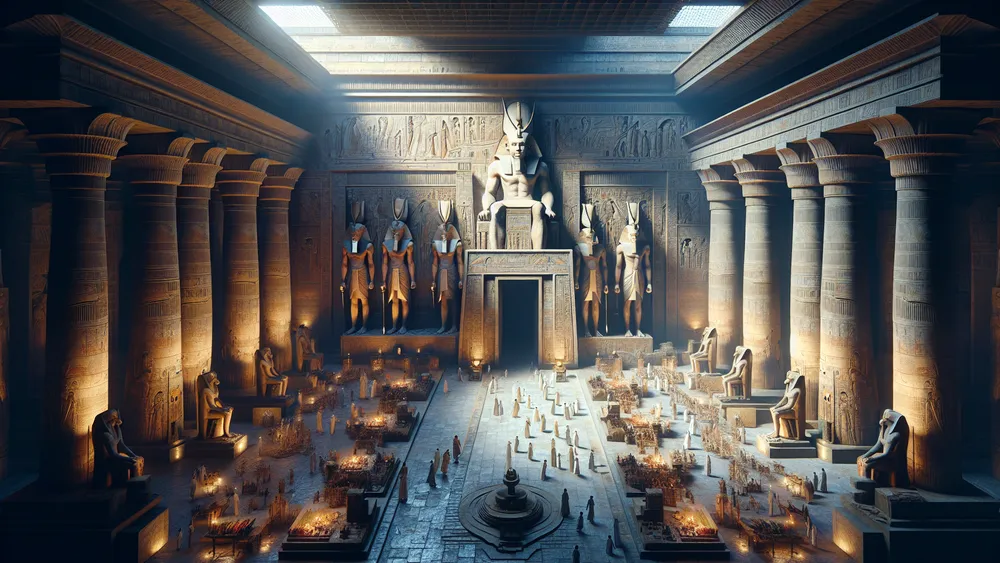
These spots’ importance in old Egyptian religion shouldn’t be overhyped. Temples were seen as homes for gods on earth, the temple of Anhur being just one example. People believed these holy areas were filled with godly energy, so they were key in keeping the balance between humans and gods. These temples also had big public and governmental roles, acting as places for learning, management, and money activities. Some big temples for Anhur are:
- The Temple of Anhur in Thinis: In Upper Egypt, a main place for Anhur’s praise.
- The Temple of Anhur in Sebennytos: In the Nile Delta, known for its detailed acts and events.
- The Temple of Anhur in Abydos: A notable site, Abydos housed many important temples.
These temples show how broad the honoring of Anhur was in ancient Egypt, showing his significance in religious and daily life.
Rituals and Celebrations for Anhur
Detailed acts and events done for Anhur were firmly set in the religious ways of old Egypt. People would bring gifts like food, drinks, and important things to Anhur’s temples, hoping for his help and safety. Priests would say songs and prayers, asking for Anhur’s strength and help, much like how today’s religious events have prayers and gifts for gods or holy people.
Parties for Anhur were also common; the community came together to celebrate his traits with parades, music, and dance. These were not only religious times but also events that made group ties stronger.
The importance of these acts in old Egyptian culture was deep. They were thought to keep the balance between human and godly worlds, making sure gods stayed happy and the community stayed well. By doing these acts, people hoped to ask for Anhur’s safety in both war and hunting, along with his good luck for a good harvest and overall well-being. Main rituals linked to Anhur include:
- The Offering of the First Fruits: People gave the first harvest fruits to Anhur to wish for more farming success.
- The Festival of Victory: After winning battles, people celebrated with parades and gifts to thank Anhur for his help in war.
- The Hunter’s Prayer: Hunters said a special prayer before going on hunts, asking for Anhur’s safety and success.
These rituals show how important Anhur was in the daily lives of old Egyptians, showing their deep respect for his power and impact.

Anhur in Today’s World
After we have looked into the old rituals and parties for Anhur, now we should look at how this strong god is shown and appreciated in our present times.
Anhur in Modern Media
Anhur shows up in different types of modern media such as movies, books, and video games, where he is often shown as a strong and mysterious character. For example, in movies, you might see Anhur as a character in films with old Egyptian ideas, like “The Mummy” series, where gods and myth figures play key roles.
Meanwhile, books sometimes feature Anhur in stories that look into Egyptian mythology, giving readers a view of his traits and tales. Likewise, video games like “Assassin’s Creed Origins” bring Anhur into the game world, letting players meet the god in a digital old Egypt. Such showings help keep the old stories alive and easy to reach for people today, similar to how Greek gods are often shown in popular media.
These showings have a big effect on popular culture; they shape how people today see and understand Anhur. By putting Anhur in different media types, creators help create a greater knowledge and love of Egyptian mythology. This teaches people about old beliefs and gets them interested in Egypt’s rich cultural past. Important modern works with Anhur include:
- “The Mummy” (1999): A movie with old Egyptian ideas and mentions of gods.
- “Assassin’s Creed Origins” (2017): A video game where players can explore old Egypt and meet its gods.
- “The Kane Chronicles” by Rick Riordan: A book series that brings Egyptian gods and myths into its story.
These works show the lasting interest in Anhur and his spot in the group of Egyptian gods, showing how old myths stay relevant in modern stories.
Anhur in Today’s Religious Practices
In modern belief systems, Anhur gets mentioned by new spiritual teams that take ideas from old Egyptian mythology. These teams might include Anhur in their acts or events, calling his traits of strength and safety. New-pagan and rebuilding groups, trying to bring back old religious practices, could include Anhur in their set of gods.
These might do acts with gifts, prayers, and symbols to honor Anhur, just like old Egyptians did. You might not know, but these ways are close to how gods from Greek or Norse myths are respected in today’s new-pagan faiths.
The importance of Anhur today is in his example of traits that echo with people now. Being a god of war and hunting, Anhur shows bravery, strength, and chasing goals, which are never out of date. His tales and traits are models and help for those who want to link with old knowledge in their spiritual path. Modern teams that show respect to Anhur include:
- Kemetic Orthodoxy: A modern belief group aiming to revive old Egyptian religious ways, including gods like Anhur.
- New-Pagan Teams: Different new-pagan teams include Egyptian gods in their practices.
- Rebuilding Groups: Teams focused on rebuilding and practicing old Egyptian religious ways.
These teams show the lasting effect of Anhur and his importance in the spiritual lives of modern followers, showing how ancient myths and gods can find new life in today’s settings.
Pantheon of All Egyptian Mythology Gods
The Egyptian group of gods is big and complex, each god having their own special traits, stories, and importance. There are well-known gods like Ra, the sun god, and not well-known gods, showing the variety of ancient Egyptian beliefs. If you want to look at the full list of all Egyptian gods, then you can find a detailed list of all the Egyptian gods.
It goes deep into the details of each god and their roles in the mythology. This source gives a good summary for anyone wanting to know more about Egyptian mythology.
FAQs
1. Who is Anhur in Egyptian mythology?
Anhur in Egyptian mythology is a god of war and hunting, often depicted as a warrior with a spear.
2. What are the main symbols associated with Anhur?
The main symbols associated with Anhur include the spear, the lion, and the khepesh sword.
3. How was Anhur worshipped in ancient Egypt?
How Anhur was worshipped in ancient Egypt involved rituals, offerings, and prayers conducted in his temples and sacred places.
4. What is the significance of Anhur in modern culture?
The significance of Anhur in modern culture lies in his representation in media and his influence on contemporary interpretations of ancient Egyptian mythology.

